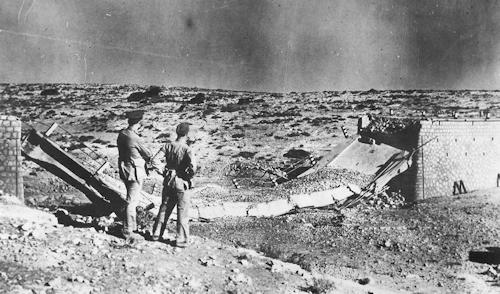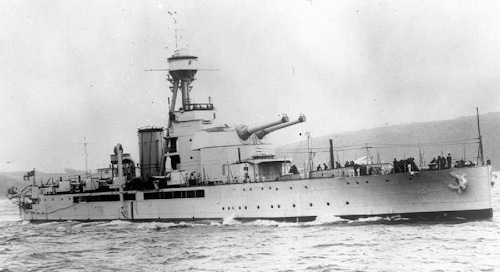The facts of Tobruk are framed in theCompass operation, triggered by the Western Desert Force by General Archibald Percival Wavell against the Italian troops stationed in Libya under the command of General Rodolfo Graziani.
It was mainly a violent clash of opposing artillery where those who were able to combine firepower with the mobility of the troops won.
Bardia had just fallen (January 3-5) and, given this outcome, it was not to be hoped that Tobruk - 22.000 men and 340 cannons for 54 km of defensive walls - could resist better and longer; worse still, there could be no illusions that the British were stopping in their offensive thrust.
Graziani had to make a decision and on 9 January he issued the directives for the arrest battle on the Derna-Berta-Mechili line, implicitly giving Tobruk lost, who was entrusted with the task of buying some time; the stronghold should have repeated the miracle of the Piave!
Since the start of the hostilities Tobruk had gone through various hands but since he was employed by the XXII Corps (18 June 1940) a series of important fortification works had begun which included fuel and ammunition deposits in caves, a water distillation plant marina and a new anti-tank ditch.
 Therefore, on 10 January the commander of the XXII Army Corps, General Enrico Pitassi-Mannella, considering the impossibility of receiving any further reinforcement from the ground, blew up the bridges on the road to Bardia and that to Derna.
Therefore, on 10 January the commander of the XXII Army Corps, General Enrico Pitassi-Mannella, considering the impossibility of receiving any further reinforcement from the ground, blew up the bridges on the road to Bardia and that to Derna.
On January 12, Graziani issued the first order of battle: the defensive wall, articulated on 16 advanced strongholds, was divided into two sectors: the eastern one blocking the origins from Bardia under the command of General Barberis and the western one under the command of General Dalla Mura, as a barrier to the origins from Derna.
The maneuvering artillery, arranged in three groups, were assigned two to the western sector (10th and 22nd regiment.) And one to the eastern sector (25th regiment. Within which the 130 howitzers group, departing from Sardinia, was framed and landed in Bengasi - via Napoli - on October 23, 1940, composed mainly of Sardinians, including my father Manlio).
Despite the measures implemented, Pitassi-Mannella had very few illusions, knowing that some deficiencies could not be filled: the positions of resistance were too large, some fortification works still incomplete and a dense and persistent dust of sand caused by the wind it could, as it actually happened, act as an artificial fog in favor of the attackers, making it impossible for the defenders to observe.
 Another unfavorable factor was the absence of aerial reconnaissance: the Piazza Command had only a couple of aircraft which not only could not go beyond the perimeter of Tobruk but sometimes not even take off due to the continuous presence of British fighters. On the other hand, thanks to aerial reconnaissance, they had acquired photographs that allowed them an accurate study of the Italian alignments.
Another unfavorable factor was the absence of aerial reconnaissance: the Piazza Command had only a couple of aircraft which not only could not go beyond the perimeter of Tobruk but sometimes not even take off due to the continuous presence of British fighters. On the other hand, thanks to aerial reconnaissance, they had acquired photographs that allowed them an accurate study of the Italian alignments.
On the Italian side, therefore, the lack of detailed information on the adversaries was greatly felt, exacerbated by the uniformity of the terrain and by the mobility of the Australian and British troops which allowed them to take up the deployment for the attack only at the last moment and almost by surprise. Furthermore, the Italians who had escaped from Bardia and Sidi el Barrani were few and too modest in rank and were able to provide reliable information on enemy tactical means and procedures.
The British forces, framed in the 7th Corps under the command of General Richard O'Connor, included the British 6th Armored Division and the Australian XNUMXth Motorized Division.
The rupture front was chosen about six kilometers east of the road to El-Adem; first the 17th and then the 16th and 19th Australian brigades would pass through the breach, while the pressure on the rest of the wall was entrusted to the two British armored brigades.
 From 00.00 to 02.00 on 21 January the HMS Terror (photo) and two gunboats opened fire on Tobruk while some destroyers intercepted the St. George to prevent him from going out to sea.
From 00.00 to 02.00 on 21 January the HMS Terror (photo) and two gunboats opened fire on Tobruk while some destroyers intercepted the St. George to prevent him from going out to sea.
Then it was the turn of the Royal Air Force whose action also served to cover the noise of armored units and moving artillery. If the naval fire, not observed, was absolutely ineffective, the aerial bombardment was heavy. By now, however, the garrison was alert; for two weeks the sensation of an imminent attack had been alive so every day at 04.30 the square was in a state of alarm, with the personnel at the combat posts. Only at 07.30, when the sun was high, was it allowed to rest for a few hours in turn. Moreover, the air raids of the 19th, with the launch of leaflets inviting to surrender, had accentuated the impression of an imminent attack, so much so that General Pitassi-Mannella had asked the Superior Command for an aerial bombardment for the morning of the 21st.
At 05.40 the British preparation was unleashed which embraced the entire southern front; the Italian artillery reacted promptly. The activity of the opposing artillery continued violently for over an hour while a large dust caused by the incoming and outgoing shots enveloped the resistance positions like an immense fog bank that prevented the detection of rockets launched from the attacked strongholds to invoke the fire of barrage. The observing officers were blind: their precarious arrangements - rung poles with an unprotected crow's nest on top - were in a very short time all demolished so that the action of the artillery groups remained bound to normal objectives with no possibility of adding up where it was greatest. the need.

Towards dawn the British fire diminished so much that the sound of armored vehicles could be heard in motion and that it was believed that calm had returned. It was simply the length of time it took for British artillery to move fire from the area chosen for the break to the deeper areas. In fact, immediately after the 17th Australian brigade, which had moved in the shelter of that fire, it launched an assault. Overcoming the obstacle was not difficult: two rows of mines and a fence quickly positioned with wooden posts badly fixed on the rocky ground! The success factors were the speed of execution, the still uncertain light, the enormous fuss over the whole sector as well as the crisis of telephone and radio connections (the linesmen and the engineers of the engineers, sent to remedy the disruption of the system of transmissions, almost all disappeared swallowed up by the fight).
At 07.00 the gash was more than a kilometer and the wagons broke through it. The first to be invested were the artillery groups of the 25th grouping where my father was; a lieutenant commander of the battery, whom I had the pleasure of meeting in Sassari forty years ago, told me that, seeing these big wagons suddenly appear, they suddenly went from barrage to direct firing until the wagons burst into the middle to men and pieces!
The fight in the artillery deployment area followed an inevitable sequence: the armored vehicles, closely followed by the Australian infantry companies, aimed at the flanks or behind the batteries whose resistance - based on the few weapons of the nearby defense - could not be long against a mobile enemy who, moreover, suddenly emerged from a sandy blanket.
 The first news of the Australian breakthrough reached the Army Corps Command at 08.45 when it had already established itself and the Australian 16th and 19th Brigades had also burst into the gap, aiming straight at Tobruk.
The first news of the Australian breakthrough reached the Army Corps Command at 08.45 when it had already established itself and the Australian 16th and 19th Brigades had also burst into the gap, aiming straight at Tobruk.
Around 10.30 the eastern sector was completely gutted. There had been episodes of tenacious and unfortunate courage and others in which the speed of an unexpected assault from various directions had prevailed over the readiness of the defense.
Meanwhile the commander of the St. George he made a request to leave the port before the square fell. The Superior Command of the Navy expressed a favorable opinion but Graziani opposed it due to the obvious negative repercussions that the cruiser's exit would have on the morale of the defenders. It was therefore decided that the ship would remain to fight ashore with its artillery as long as possible. Then it would sink.
While the events described were unfolding, the western sector held. Only in the late afternoon did units of the British 7th Armored Brigade infiltrate the strongholds at the northern end of the resistance position.
By evening more than half of the square was in Australian hands. During the night, plans were developed to destroy everything that was not to be exploited by the enemy: distillers, fuel and ammunition depots, vehicles and artillery. At 04.15 on 22 la St. George (photo) self sank.

General O'Connor knew he had won the game and at dawn on the 22nd he ordered that the advance be resumed in all directions. There was no more organized resistance. Every residual element of the square defended itself. Around 16 pm the entire Command of the XXII Army Corps fell prisoner and with him General Pitassi-Mannella (the war will end in a prison camp in India). The rest of the day of the 22nd and the whole of the 23rd were nothing more than a continuous round-up of materials and prisoners.
The 400th British Army Corps had just over 355 casualties of which 780 were Australians. The Italian losses were around 2000 dead, 22.000 wounded and XNUMX prisoners.
A few days later a "biblical" exodus would begin for them on foot along the Via Balbia to the port of Sollum, then boarding the ships for Alexandria in Egypt and the sorting camps on the Suez canal from where some would take the road to India, others to Kenya; but the mass, including my father, found themselves in what was later considered the largest prison camp built by the allies in the 2nd World War, where it is estimated that about 107 Italian prisoners passed through: Sin water in South Africa… but this is another story!
Giovanni Sulis (general of ca on leave)

Photo: web












